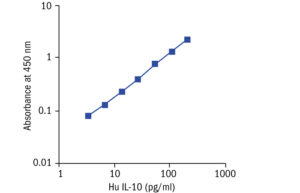Interleukin-10 Human ELISA
Interleukin-10 is a pleiotropic cytokine playing an important role as a regulator of lymphoid and myeloid cell function. Due to the ability of IL-10 to block cytokine synthesis and several accessory cell functions of macrophages this cytokine is a potent suppressor of the effector functions of macrophages, T-cells and NK cells. In addition, IL-10 participates in regulating proliferation and differentiation of B-cells, mast cells and thymocytes. The primary structure of Human IL-10 has been determined by cloning the cDNA encoding the cytokine. The corresponding protein exerts 160 amino acids with a predicted molecular mass of 18.5 kDa. Based on its primary structure, IL-10 is a member of the four a-helix bundle family of cytokines. In solution Human IL-10 is a homodimer with an apparent molecular mass of 39 kDa. Although it contains an N-linked glycosylation site, it lacks detectable carbohydrates. Recombinant protein expressed in E. coli thus retains all known biological activities. The Human IL-10 gene is located on chromosome 1 and is present as a single copy in the genome. The Human IL-10 exhibits strong DNA and amino acid sequence homology to the murine IL-10 and an open reading frame in the Epstein-Barr virus genome, BCRF1 which shares many of the cellular cytokine’s biological activities and may therefore play a role in the host-virus interaction.
The immunosuppressive properties of IL-10 suggest a possible clinical use of IL-10 in suppressing rejections of grafts after organ transplantations. IL-10 can furthermore exert strong anti-inflammatory activities. IL-10 in disease: IL-10 expression was shown to be elevated in parasite infections like in Schistosoma mansoni, Leishmania, Toxoplasma gondii and Trypanosoma infection. Furthermore, high IL-10 expression was detected in mycobacterial infections as shown for Mycobacterium leprae, Mycobacterium tuberculosis and Mycobacterium avium infections. High expression levels of IL-10 are also found in retroviral infections inducing immunodeficiency.
Research topic
Cytokines and chemokines and related molecules
Type
Sandwich ELISA, Biotin-labelled antibody
Applications
Serum, Plasma-Heparin, Plasma-Citrate, Cell culture supernatant
Storage/Expiration
Store the complete kit at 2–8°C. Under these conditions, the kit is stable until the expiration date (see label on the box).
Calibration Curve

– Tsigou E, Stavros A, Pavlos M, Stavros G, Athanassios T, George B. The immune response after stimulation with wall components of gram-positive bacteria and fungi. Immunol Lett. 2014 May-Jun;159 (1-2):23-9

